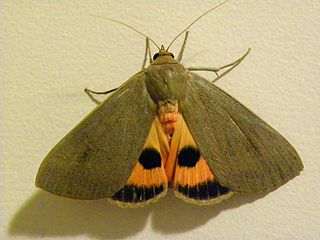
Spilomelinae is a very species-rich subfamily of the lepidopteran family Crambidae, the crambid snout moths. With 4,132 described species in 340 genera worldwide, it is the most speciose group among pyraloids.

The Pyralinae are the typical subfamily of snout moths and occur essentially worldwide, in some cases aided by involuntary introduction by humans. They are rather rare in the Americas however, and their diversity in the Australian region is also limited. Altogether, this subfamily includes about 900 described species, but new ones continue to be discovered. Like many of their relatives in the superfamily Pyraloidea, the caterpillar larvae of many Pyralinae – and in some cases even the adults – have evolved the ability to use unusual foods for nutrition; a few of these can become harmful to humans as pests of stored goods.

The Pyralini are a tribe of snout moths described by Pierre André Latreille in 1809. They belong to the subfamily Pyralinae, which contains the "typical" snout moths of the Old World and some other regions. The genus list presented here is provisional.

Orthonama obstipata, the gem, is a moth of the family Geometridae. The species was first described by Johan Christian Fabricius in 1794. It is a cosmopolitan species. In continental Europe though in the northeast, its range does not significantly extend beyond the Baltic region and it is absent from northern Russia. This well-flying species is prone to vagrancy and able to cross considerable distances of open sea; it can thus be regularly found on the British Isles and even on Iceland.

The brown-dotted clothes moth is a species of tineoid moth. It belongs to the fungus moth family (Tineidae), and therein to the nominate subfamily Tineinae. It is the type species of its genus Niditinea.

Arrade leucocosmalis, the garden snout, is a moth of the family Erebidae. The species was first described by Francis Walker in 1863. It is found in Victoria, Australia.

Thallarcha sparsana, the fair footman, is a moth of the subfamily Arctiinae. The species was first described by Francis Walker in 1863. It is found in the Australian states of Victoria, New South Wales and Queensland.

Hednota pleniferellus is a species of moth of the family Crambidae. It is found in Australia, in Queensland, New South Wales, Victoria, and Tasmania.

Scirpophaga is a genus of moths of the family Crambidae described by Georg Friedrich Treitschke in 1832. Asian species include significant rice stemborer pests.

Arsacia is a monotypic moth genus of the family Noctuidae. Its only species is Arsacia rectalis. Both the genus and species were described by Francis Walker, the genus in 1866 and the species in 1863. It is found from the Indo-Australian tropics of India, Sri Lanka to Queensland and the Solomon Islands.

Sandava is a genus of moths of the family Erebidae. The genus was erected by Francis Walker in 1863.
Arcina is a monotypic moth genus in the family Geometridae. Its only species, Arcina fulgorigera, is found in Australia. Both the genus and species were first described by Francis Walker in 1863.

Phrataria is a genus of moths in the family Geometridae erected by Francis Walker in 1863. All the species in this genus are known from Australia.

Zermizinga is a moth genus in the family Geometridae erected by Francis Walker in 1863. Species within this genus include Zermizinga sinuata, the lucerne looper or spider moth, which was described by Warren in 1897, as well as Zermizinga indocilisaria, which was described by Walker in 1863.
Acridotarsa is a genus of moths belonging to the family Tineidae. The genus was described by Edward Meyrick in 1893.

Berta chrysolineata is a species of moth of the family Geometridae described by Francis Walker in 1863. It is widespread from the Indo-Australian tropics of India, Sri Lanka to the Solomons.

Oenochrominae is a subfamily of the moth family Geometridae.

The Chrysauginae are a subfamily of snout moths. They are primarily Neotropical and include about 400 described species.

Targalla subocellata is a moth in the family Euteliidae first described by Francis Walker in 1863. It is found in Taiwan, the north-eastern part of the Himalayas, Sundaland, the Philippines, Sulawesi, the southern Moluccas, New Guinea and Queensland.

Zeuctophlebia squalidata is a species of moth of the family Geometridae first described by Francis Walker in 1863. It is found in Australia.



















